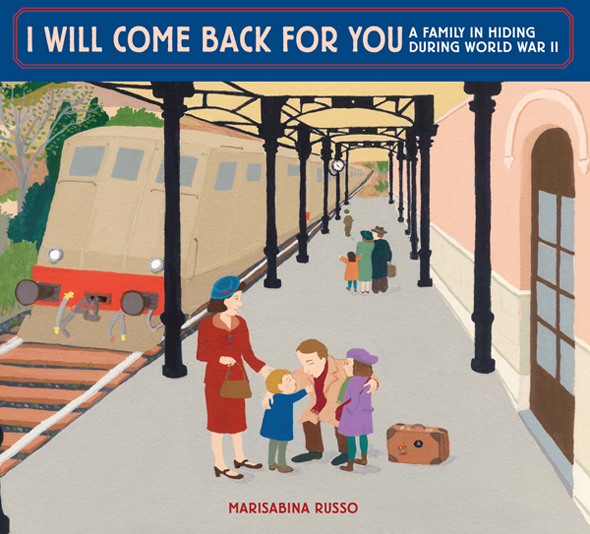
I Will Come Back for You
A Family in Hiding During World War II
خانوادهای در طی جنگ جهانی دوم مخفی شد
فرمت کتاب
ebook
تاریخ انتشار
2011
Lexile Score
670
Reading Level
2-3
ATOS
3.6
Interest Level
K-3(LG)
نویسنده
Marisabina Russoشابک
9780375985157
کتاب های مرتبط
- اطلاعات
- نقد و بررسی
- دیدگاه کاربران
نقد و بررسی

Starred review from June 20, 2011
Why does Nonna have such curious charms on her braceletâand why does she never take the bracelet off? The story takes her granddaughter and readers back to Rome during WWII, when Nonna and her family, along with other Jews, were caught in the ever-tightening grip of the Nazis. Each of the seven charms represents moments of hope and horror: a donkey reminds Nonna of the cart that took her, her brother, and her mother to visit Papà after he was detained; the tiny pig prompts the telling of how Nonna and her brother, separated from their mother for weeks, hid in baskets of real piglets while escaping into the mountains to be reunited with her. As she did with Always Remember Me: How One Family Survived World War II (2005), Russo bases this book on her own family history. Her writing is direct but always reassuring, and her naïf gauche illustrations, rendered in saturated autumnal tones, feel very close to the actual family photographs that serve as the book's endpapers. Ingenuity and compassion are recurring themes in this eloquent portrayal of a family's struggle for freedom. Ages 5â9.

August 1, 2011
A fictionalized Holocaust account that may make readers wonder why the author didn't trust her own story.
Nonna, the grandmother who narrates this story, has tiny charms on her bracelet: a donkey, a piglet, a spinning wheel, a boat. Each item reminds her of her escape from Italy during World War II. She and her brother hid in a basket full of pigs, on its way to a farm in the country. They sailed on a boat to America. Some children will think the charm bracelet is exactly right, the perfect storybook image to sum up her escape. More skeptical children will say: Wait, did the person who made the bracelet have a spinning-wheel charm just sitting around? Or did someone ask him to make a spinning wheel, even though the wheel was just a small part of Nonna's story? Children who read all the way through the afterword will find out that there was no charm bracelet in real life, and, actually, Nonna was a boy. Russo has turned their story into a little fable, a small, snapshot version of the war. The real history is moving its own right and full of miraculous escapes, but it isn't a fable.
Some readers will love the little miracle of the charm bracelet. Others will want the whole truth, even if it isn't a tidy story. (Picture book. 6-11)
(COPYRIGHT (2011) KIRKUS REVIEWS/NIELSEN BUSINESS MEDIA, INC. ALL RIGHTS RESERVED.)

October 1, 2011
Gr 2-4-Russo tells a simplified version of her Jewish family's World War II experiences in Italy. A modern framing story provides comforting distance, and the tale of family separation, hiding, and a father's (offstage) death is told with great sensitivity. The warm gouache paintings make the family's affection clear and emphasize the positive moments they are able to snatch during this terrible time. Period photographs of Russo's family decorate the endpapers. This is a fictionalized memoir from the point of view of an individual child; it bears witness to but does not teach history or expound on major themes or lessons of the Holocaust. While it is well written and beautifully illustrated, it joins a crowded field of Holocaust testimony and stands out only for the extreme gentleness of its style. Its picture-book format and sweet illustrations may make it a difficult sell for older readers who are ready to learn about this harsh history, while its content may raise troubling questions among younger readers for whom its format is most appropriate. A title such as this should be used judiciously, with adult guidance.-Heidi Estrin, Feldman Children's Library at Congregation B'nai Israel, Boca Raton, FL
Copyright 2011 School Library Journal, LLC Used with permission.

October 1, 2011
Preschool-G Drawing on Russo's family history, this moving picture book tells a story of sorrow, fear, courage, and kindness during WWII. Nonna shares her memories with her grandchild about growing up in a happy Jewish family in Rome until things changed for the Jews in Italy, and Papa was sent to the mountains. At first, the family could visit him on weekends. Then, after the Germans sent him to a concentration camp, Papa ran away. Soldiers came to arrest Mama, but her neighbors helped her hide and cared for the children. With lots of sepia family photographs on the endpapers, an afterword fills in the facts, and the bright, clear, gouache illustrations on watercolor paper stay true to the child's viewpointconfused and sad about the separation and secrets, until there is a joyful reunion with Mama. The children never saw Papa again, though, and a closing page without pictures, just text against a black background, has a powerful effect. A fine addition to the Holocaust curriculum.(Reprinted with permission of Booklist, copyright 2011, American Library Association.)

























دیدگاه کاربران